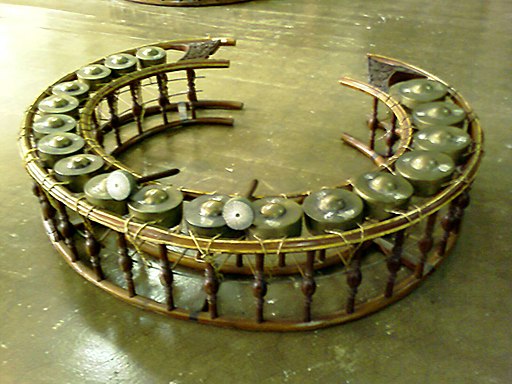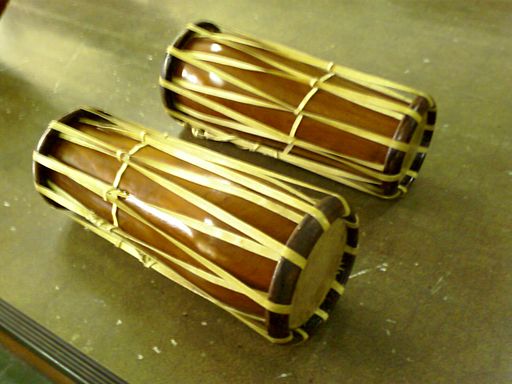OK! The first article I want to introduce in this blog is Thai Music Instrument. And the first kind of instrument is percussion. It divided to 3 groups:
1. Xylophone
1.1
Ranad ek (ระนาดเอก in Thai)
This is an instrument many people in the world know well about. It has 21 or 22 wooden bars(Mostly 22), suspended by two ropes over boat-shaped resonator. Typically made from rosewood (
Thai: ไม้ชิงชัน
; Mai ching chan) or bamboo. Each bar is tuned by a lump of lead and beewax mixture, stuck under the head and the end of a bar (Ranad tum, which I'm going to introduce, is tuned in this way,too). It is played by two types of mallets; hard and soft. There is a counterpart of this instrument in Cambodia called
ronaet ek and in Laos called
nang nad ek.
Ranad ek is the leading instrument of the
pipat (ปี่พาทย์) and
mahori (มโหรี).
The photo above is mine, Chayanin Nualla-ong. Copyrighted.
1.2
Ranad Tum (ระนาดทุ้ม in Thai)
It has 18 bars, suspended over resonator. Typically made from bamboo. Pitch range is lower than ranad ek. It is usually played in accompaniment with ranad ek.
This photo is owned by Paul_012 under Creative Commons license.
http://upload.wikimedia.org/wikipedia/commons/thumb/c/ca/Ranat_thum.jpg/512px-Ranat_thum.jpg
1.3
Ranad ek lek (ระนาดเอกเหล็ก)
It is a metallophone, consist of metal slabs, (The same number to ranad ek.) placed on rectangular resonator. Its range of pitch is similar to ranad ek. Played with two bamboo sticks with padded ends.
This photo is owned by Paul_012 under Creative Commons license.
http://upload.wikimedia.org/wikipedia/commons/thumb/0/0e/Ranat_ek_lek.jpg/512px-Ranat_ek_lek.jpg
1.4
Ranae tum lek (ระนาดทุ้มเหล็ก)
Another metallophone. Its pitch is same to ranad tum.
This photo is owned by Paul_012 under Creative Commons license.
http://upload.wikimedia.org/wikipedia/commons/thumb/1/16/Ranat_thum_lek.jpg/512px-Ranat_thum_lek.jpg
2. Gong
2.1
Kong wong yai (ฆ้องวงใหญ่)
A circle-shaped instrument. It has 16 brass gongs in rattan frame and each gong is tuned by beewax. It is played "main melody" of ensembles. Any student who want to learn pipat ensemble have to learn Kong wong yai.
This photo is owned by Paul_012 under Creative Commons license.
http://upload.wikimedia.org/wikipedia/commons/thumb/c/c4/Khong_wong_yai.jpg/512px-Khong_wong_yai.jpg
2.2
Kong wong lek (ฆ้องวงเล็ก)
Same shape as kong wong yai but higher pitch and has 18 gongs in frame.
This photo is owned by Paul_012 under Creative Commons license.
http://upload.wikimedia.org/wikipedia/commons/thumb/4/4e/Khong_wong_lek.jpg/512px-Khong_wong_lek.jpg
3. Drum
3.1
Tapone (ตะโพน)
My own photo.
Known as "the master of Thai instruments". It is considered a particularly a sacred instrument and should be kept in the higher place than other. It is played only in pipat ensemble.
It is woven by a string made by cow skin.
Tapone is tuned by a paste made of rice and ashes. It is played with hand.
3.2
Glong tad (กลองทัด) Barrel-shaped drums. Play with large wooden sticks. Usually played in pair with tapone.
3.3
Glong khaek (กลองแขก)
Two double-headed hand drums. There are two types:
tua pu (male), high pitch one, and
tua mia (female), a low pitch one. Usually played in pair with two players. However, it can be played in a single player.
Thai students who learn Thai music usually played these instruments.
Klong khaek can be played in all ensemble.
This photo is owned by Paul_012 under Creative Commons license.
http://upload.wikimedia.org/wikipedia/commons/thumb/e/eb/Klong_khaek.jpg/512px-Klong_khaek.jpg
3.4
Thon (โทน) Single-headed hand drum. There are two type of thon:
thon chatri for southern Thai performance,
chatri. Played in pair. And another type:
thon mahori for
mahori ensemble. Its body is made from ceramic or wood. Played with smaller rammana.
3.5
Rammana (รำมะนา) ts body is made from ceramic or wood. Played with bigger thon.
Both thon and rammana are played in
krueang sai ensemble.
My own photo. The left one is rammana. The right one is thon.
3.6
Glong song na (กลองสองหน้า)
My own photo.
Song na means two heads. It is woven like tapone but longer body. Played in pipat ensemble.
I'm sorry that I can't find a picture of glong tad right now.













